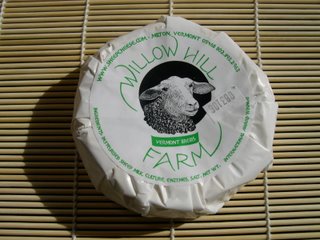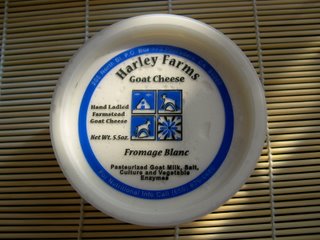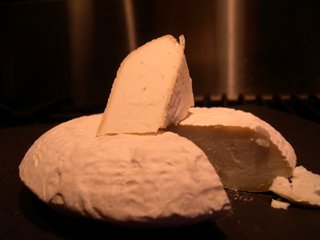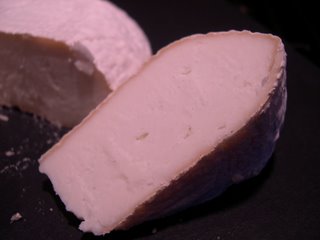
The caerphilly is aging nicely. It should be ready in a couple of weeks. I have a new Sarahmore drying. Tomorrow I will salt it, let it sit some more and then into the cave it shall go for 3-4 weeks. This is getting to be a habit.
Rant time:
If you're curious about why raw milk and its providers are hard to find, take a look at this editorial about a cow-share program in Michigan that was stopped.
*******************
Business Week editorial:
*******************
States Target Raw-Milk Farmers
Michigan is the latest to bust a provider of unprocessed milk-and its
heavy-handed tactics may put three small farms out of business
by David E. Gumpert
For several months over this past summer and fall, Michigan
authorities tracked Richard Hebron, 41, and his weekly truck hauls the
140 miles or so from Vandalia to Ann Arbor. To gather evidence, an
undercover agent infiltrated an organization that was making private
purchases from Hebron.
On the morning of Oct. 13, the authorities closed the loop on their
complex sting operation. Just outside of Ann Arbor, a state police
officer pulled over Hebron's truck during its weekly run, served
Hebron with a search warrant, and with several other agents began
removing goods from the truck.
Back home in Vandalia, a state trooper accompanied by four
plain-clothes agents knocked on the door of Hebron's home, presented
Hebron's wife, Annette, with a search warrant, and fanned through
their small three-room house, removing their computer, business
records, and product samples. Later that afternoon, in Ann Arbor, four
additional agents, also armed with a search warrant, rummaged through
a warehouse that was Hebron's destination when he was pulled over,
seizing more business records.
Expanding Investigation
The trigger in this huge investigation? No, it wasn't drugs, stolen
goods, or terrorism. It was, of all things, raw milk and its various
byproducts, including cream, buttermilk, yogurt, butter, and kefir.
The Michigan Agriculture Dept., which oversaw the investigation
together with the Michigan State Police, sees the situation as a
simple matter of enforcing the law. Unfortunately, when it comes to
raw milk, the law is no simple matter.
"We've had an investigation for several months now," says Katherine
Fedder, director of the Michigan Agriculture Dept.'s food & dairy
division. The investigation, she says, began with a report from a
local public-health department last spring about children who had
become sick who " had consumed unpasteurized milk." She noted, though,
that the children's illness was never traced back to raw milk or any
other specific food. In any event, a department inspector joined the
co-op to purchase milk and expand the investigation.
"Our concern is that there's a violation of the Michigan law to
distribute misbranded products and unpasteurized dairy products out of
an MDA-licensed food establishment," Fedder says, adding that the
investigation of the computers, records, and milk products confiscated
will likely take "a few more weeks before we have a clarification."
Then, Hebron and/or the co-op could be charged with "a whole variety
of things" under a Michigan food law and a dairy law.
Crippled Co-op
Hebron is a farmer with about 110 acres, where he raises beef, cattle,
and chickens. He also manages the four-year-old Family Farms Co-op
with two other farm families, through which all three farmers sell
their products at the Ann Arbor outlet, as well as two outlets in
Detroit and seven in Chicago.
One of those farm families, an Amish couple with eight children, owns
the 70 milking cows that produce the cooperative's raw milk (milk that
isn't pasteurized or homogenized). The Amish farmer doesn't have a
phone or other modern conveniences and couldn't be reached. Hebron
says the farmer has requested Hebron to speak both on the co-op's and
the farmer's behalf and not to publicize his identity. This farmer is
essentially out of business for the time being, and has had to throw
out all his milk produced since Oct. 13.
The entire co-op is crippled, since the farmers are without their
computer, fax, or business records. And already three Chicago retail
outlets, unsettled by news of the Michigan officials' actions, have
told Hebron not to bother returning with additional products. "This is
what we do for a living," says Hebron. "We don't get unemployment
checks."
The experience has left the Hebrons shaken. "They treated us pretty
much like we were drug dealers," he says. Moreover, it's not clear if
any of the co-op members will be charged with a crime and when the
co-op may be able to resume its normal business.
Worse than Russia?
The Family Farms Co-op thought it had dealt with the Michigan
prohibition against retailing raw milk, which is similar to
prohibitions in many other states, four years ago, when it set up the
co-op. Under the arrangement, the co-op leases cows from the dairy
farm and then sells shares in the herd to co-op members, each of whom
pays $20 a year for their share. The co-op members purchase milk for
$6.50 a gallon, which goes back to the dairy farmer in the form of a
boarding fee for the cows.
"It has to be this way, because it's illegal to sell raw milk retail"
in Michigan, says Hebron. Michigan law allows for people who own and
board dairy cows to consume their milk, though.
After I listened to Hebron tell his story about the state police and
agriculture inspectors refusing to let him make a call home after
confiscating thousands of dollars worth of fresh farm products from
his truck, and then serving a search warrant on his wife and rummaging
through the farm family's home, I asked him, "Could you believe this
was happening in the United States?"
"No," he said. "I have a customer in Chicago who says he's from
Russia. He thinks this is worse than what happens in Russia."
Crackdown Factors
This harsh Michigan action bears an eerie resemblance to the case of
Organic Pastures Dairy, a producer of raw milk, which California
agriculture officials shut down for more than two weeks (see
BusinessWeek.com, 9/28/06, "Getting a Raw Deal?"). California
authorities went after Organic Pastures when four children became sick
from E.coli bacteria, but an exhaustive investigation turned up no
evidence of E.coli at the dairy. In comparison, even though 200 people
were sickened by E.coli from California spinach, none of the
California spinach farms were shut down.
What's behind these crackdowns by major states against producers of
raw milk? I suspect it's a combination of two forces at work.
First, there's the simple matter of growing demand from consumers
seeking food with as little processing as possible, who want to buy it
from local farm producers (see BusinessWeek.com, 10/16/06, "The
Organic Myth"). Organic Pastures has seen its revenues climb 35% to
40% annually since it switched to selling raw milk in 2000. Similarly,
the Family Farms Co-op has grown from nothing to nearly 1,000 members
over the last four years.
Out of Proportion
Second, as raw milk and organic milk (milk which is pasteurized, but
obtained from cows fed organic feed, with no hormones) become more
popular, large dairies are becoming concerned and exerting pressure on
agriculture officials to crack down on the raw-milk producers. Just
take a look at the Web site milkismilk.com to get a sense of the
conventional dairies' concern.
Regardless of what anyone may think about raw milk, the heavy-handed
enforcement action by Michigan authorities just feels
inappropriate-way out of proportion to any possible violation of the
law. It smacks of a speed-trap approach to law enforcement, except
here the penalty isn't just a fine, it's the livelihood of three
family farms.
(Note: I will be following the unfolding situation at Family Farms
Co-op, much as I have the Organic Pastures situation, at my blog,
thecompletepatient.com.)
Gumpert is author of Burn Your Business Plan! What Investors Really
Want from Entrepreneurs and How to Really Start Your Own Business. His
Web site is www.davidgumpert.com.
Thursday, October 26, 2006
Aging nicely and the raw deal for raw milk
Posted by
Sairbair
at
12:05 AM
0
comments
![]()
Monday, October 23, 2006
Fin de Semana de Queso
 A glimpse of Cowgirl on a Saturday in August. Stephanie, Daniel, and Janet working the crowd. Janet has moved to DC to work at the new shop on F Street. Stephanie wears many hats. Check out her blog The Grub Report.
A glimpse of Cowgirl on a Saturday in August. Stephanie, Daniel, and Janet working the crowd. Janet has moved to DC to work at the new shop on F Street. Stephanie wears many hats. Check out her blog The Grub Report.
I had a very cheese-filled weekend. I spent Saturday morning working from 8:00am -2:30pm working at Cowgirl Creamery. I called it a guest appearance. Several of my fellow cheesemongers asked if I was coming back for good. I love cheese. I love selling cheese. The customer interaction is really gratifying. I feel like the cheese fairy, spreading happy cheese blessings where ever I go. Offering tastes of creamy goodness to people who are eager to try something new. I like to share my passion. Returning to the cheese counter is fun for me also, because there are new cheeses! Yet, I get the most pleasure out of making cheese.
There is a new Cowgirl Cheese called Inverness. It is a "lactic" cheese and a work in progress. It has a bloomy rind like Mt. Tam, but it has a lighter texture. It is shaped like a large, white thimble. The taste is slightly tart, and dissolves on the tongue with a creamy finish. This is a style of cheese that I'm still trying to figure out. Lactic cheese is a type of fresh cheese but it is also used as a descriptive term. Starter culture and a little bit of rennet is added to warm milk and left to sit for several hours (usually overnight). The milk turns into a thick yogurt consistancy. This curd is not cut but poured into a colander lined with cheesecloth. The four corners of the cheesecloth are tied together and the curds are left to drain for several hours. Since the curds are not cut, less whey is expressed and the cheese is very soft and spreadable. It is used like cream cheese or fromage blanc. Cowgirl's is left to age until a bloomy rind has grown. P. candidum must be added to the milk or sprayed on to the young cheese and left to age for a couple of weeks. I'm just guessing. I haven't been to the creamery to ask.
But I digress. Other new cheese: Two from Vermont Butter and Cheese company, soft spreadable goat cheeses with funky rinds. They come in cute little wooden trays. Jasper Hill Farm in Vermont has a new blue cheese, similar to a stilton. Fun! There is a fresh sheep's milk cheese from Wisconsin in the fresh case. Similar in texture to a fresh chevre, but it is more mild and has a rich, slightly sheepy(?) finish. I like it.
Also new to Cowgirl, more cheese from Vermont: Willow Hill Farm. They are an organic sheep dairy, who also sell fresh lamb, wool, blueberries, blankets in addition to sheep's milk cheese and yogurt. Cowgirl is carrying Vermont Brebis and Alderbrook and their yogurt. Both cheeses are cave aged, bloomy rinded and very runny. I have a Brebis that I need to try. It looks like a small camembert and feels very soft.
I can't wait to try it this afternoon. I think I'll get a loaf of french bread and a spoon. It is quite ripe.
By the way, Jim has put me on notice. No more cheese can enter the house until we finish what we have. I've been on a spending spree it seems. I can't go into a market without examining the cheese section thoroughly. I call it research. Jim calls it overkill. "Enough, dear. No more cheese for the rest of the month," he said last week. "But, but....O.K. I guess the fresh goat cheese log from Spain, the wedge of Basque sheep/goat tomme, Parmiggiano Reggiano, cave aged gruyere, my own Faux Ticklemore - now called Sarahmore (thanks Cynthia!) and my own fresh chevre are enough. I'm not counting the overripe little morsels of soft, French sheep's milk cheese, nor the tiny reminants of Harbourne that are still floating around in the veggie drawer. The promise went by the wayside after Saturday's stint at the shop. I had to try that Vermont Brebis. I've also got some Straus yogurt in my fridge as well as Bellwether Farms Creme Fraiche. There are two gallons of Clover milk waiting to be turned into cheese. I do my best to support the dairy industry. If you follow the Clover link, look at the billboards on Clover's website and check out 1989. A few of my favorites are there, especially #3.
Sunday we drove down the San Mateo coast to Half Moon Bay. It is pumpkin season. Jim and I love roaming around pumpkin patches to find the "right" squash to turn into jack-o-lanterns. The more misshapen the better. We've had good luck at Bob's Pumpkin Patch in the past. The have acres of them and you can even pull them off of the vine. This year produced some good ones. We've found a huge, pear shaped squash that's still kinda green. We yanked it off the vine and put it into the wheelbarrow. Soon five more orange pumpkins were added to the wheelbarrow. We're ready for Halloween now! It was around 2:30, too early to head home, so we drove 20 minutes south to Pescadero to grab some soup and olallieberry pie at Duarte's (pron. Doo'-arts) a tavern that specializes in cream of artichoke soup, fresh seafood and pie. Their cream of chile soup is amazing, too.
Since we were in Pescadero, and I wasn't that hungry yet, I suggested we drive over to Harley Farms, a farmstead goat cheese maker. It is on the edge of town (three blocks from "downtown") in Pescadero. We drove up to the the farm and they were open. Yay! The goats were casually walking around the pasture and checking out the tourists near the gate. We went into the barn which is Harley Farms' shop and make room. Next door is the milking parlor. There are large windows to allow for plenty of light and lets folks watch the exciting work of milking goats or making fresh goat cheese.
Inside the shop, Dee Harley was selling her cheese and swatting flies. A big, grey cat was dozing in a patch of sun on the floor. We entered the small storefront and sampled Dee's assorted cheeses that lined the counters. They were hidden under cheesecloth to protect them from flies and the sun. We sampled her chive logs, goat ricotta, fromage blanc, and other delicious goat cheeses. Locals came in and grabbed their weekly supply of fresh cheese, paid and left. We bought a tub of fromage blanc and chatted with Dee. She's going to the Slow Food Terra Madre gathering in Turino, Italy this week. The Slow Food gathering is getting to be quite the shindig. Cheesemakers (and others) from England, the USA, and I'm sure most of Europe decend on Italy to meet and talk about sustainable food production and issues like EU and FDA regulations that kill traditional methods of food preparation. A lot of eating happens. I have seen photos of multitude of cheeses to try. I'd like to go someday, but I'd like to have something to show for myself. Slow Food's Terra Madre is to the food scene as South By Southwest is to the music world. Everybody shows up and people enjoy themselves. 600 international cheeses vs. 600 international bands. Dee was excited to be going and representing American cheesemakers (even though she's English).
We talk to Dee for a while. I told her that I've been making cheese at home and abroad. She was very supportive and gave us lots of advice. We really hit it off with her. She invited us to go and say hello to her 200 goats. How could I resist? We walked through the gate and were greeted by some very friendly Alpine does. The stinky billy goat was walking around making sure his girls were happy. We scratched ears and talked to the girls. It was a nice way to spend an hour. Dee invited us back in the spring when the kids are around and the milk is at its finest.
We'll be back!
Posted by
Sairbair
at
10:44 AM
0
comments
![]()
Labels: Cowgirl Creamery
Monday, October 16, 2006
We have a cheese!

Yippee! We have success! The faux Ticklemore Goat, is out of the cave. Jim and I broke into it last night. Jim was taking the recycling downstairs when I was about to cut into it. "Wait!" he shouted. "I want to be here for this!" OK. I waited. I grabbed my handy IKEA cheese hatchet for the big event. While I was waiting for Jim, I examined the small disk of cheese. The wheel feels harder than I had anticipated. There is very little give. It definitely looks edible. It smells edible, too. Slightly earthy, like a button mushroom. Jim arrives back in the kitchen and I take the knife and cut the cheese. It cuts through the disk easily enough but I can tell it is a hard cheese, beyond firm. I make another incision and pull out a wedge of cheese from the wheel. It looks like a small, white slice of pie. Jim and I look at it. It has perfect rind formation. There is a nice layer of p. candidum dusting the rind. There are a few tiny eyes in the body of the cheese. I break a piece off of the wedge. It snaps apart. Ah. Way too hard. I smell. It is slightly goaty and clean smelling, still with a hint of white mushroom. Good. We taste it.
It is good! The texture is too hard, but the flavor is there. Mild and mushroomy, but has slight citrus overtones. I really like it. I'd make it again, with some alterations. I'd cut the curds a bit larger. I'd stir it more gently, perhaps with my hand. Now I get to tinker with the recipe. This is why it is critical to keep notes on your make procedure. What did I do last time? What should I change this time? Yay!
Last week I made another cheese. I really like caerphilly, a cow's milk cheese from Wales. I have recipe for it in one of my many cheese books so I thought I'd give it a whirl. I procured two gallons of non-homoginized milk from Other Avenues and Trader Joes. Other Avenues carries Straus Family Creamery milk. TJ's has their own "cream top" organic milk from Northern California. I thought I'd give them a taste test. Straus milk is in glass. TJ's milk is in plastic. Straus tasted better hands down. I think it is the fact that plastic adds a flavor to milk. Glass adds no off taste. Straus, however is now bottling their milk in plastic, too. I'll have to try this comparison again with each milk in plastic bottles. Taste test over, I made some cheese.
I had to leave it to dry on the counter for several days. Now it is in the fridge, aging for three to six weeks. I'll see how long I can wait.
Posted by
Sairbair
at
9:59 AM
0
comments
![]()
Labels: Ticklemore Cheese Devon England
